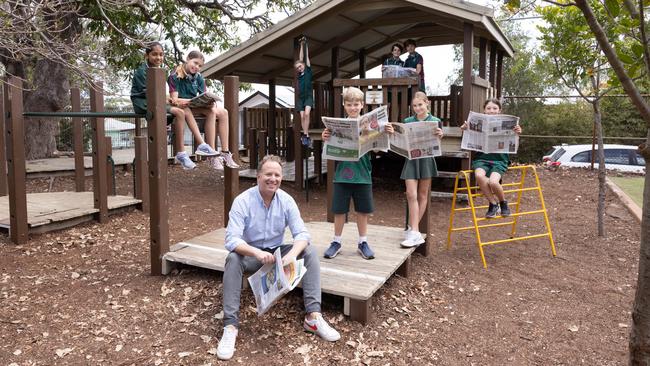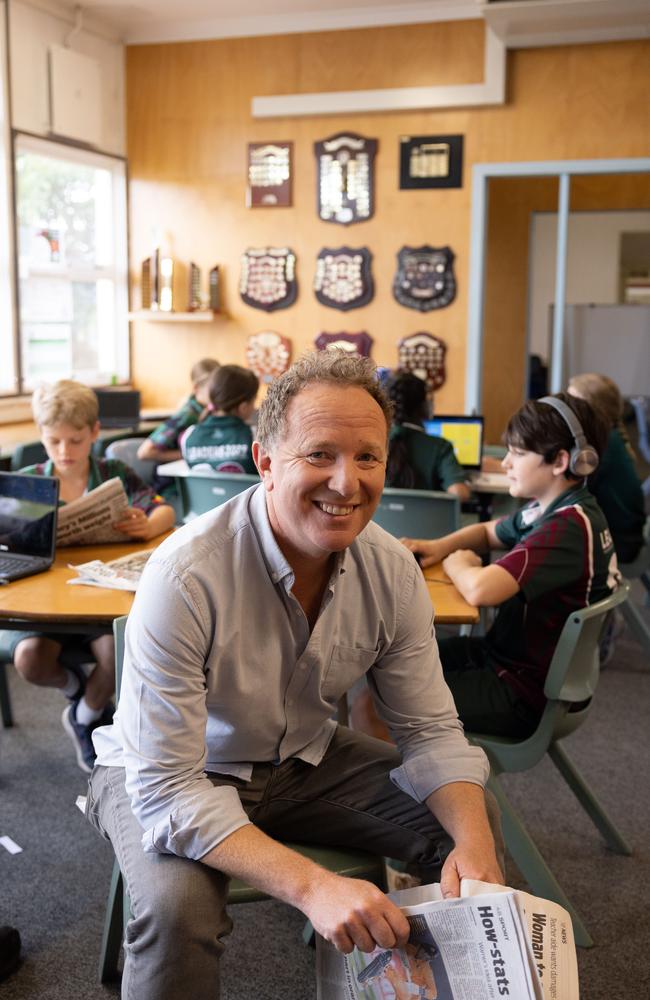‘Regurgitate things they’d seen on TikTok’: How to teach kids not to believe everything they see online
You can’t believe everything you see online, but how are our kids meant to know that? Here are the top tips for teaching your kids how to sort fact from fiction.

News
Don't miss out on the headlines from News. Followed categories will be added to My News.
As a kid, Bryce Corbett watched the evening news on a big box TV and flicked through broadsheet newspapers that lay scattered around the house. Now a father of two, he can barely believe how much misinformation and media his children are exposed to these days.
“When my kids were eight and 10, I was watching with interest and a bit of a rising sense of horror their media consumption habits and how very different they were to my own when I was their age,’’ Corbett, 52, says.
“Increasingly they were coming to the dinner table and regurgitating things they’d picked up online while watching YouTube or flicking through TikTok or Instagram. I was constantly saying to them, ‘you know you can’t believe everything you read or see online’.’’

Having worked as a journalist for the Australian Financial Review, 60 Minutes, The Daily Telegraph and the Australian Women’s Weekly for over 25 years, Corbett started wondering how he could use his experience to help the next generation navigate the rapidly changing media landscape.
“It occurred to me that kids were being exposed to more information than any other time in history and weren’t being taught how to consume that media in a critical way,” he says.
Corbett soon partnered with TIME magazine journalist turned school teacher Amanda Bower to develop a fun and engaging media literacy program for Australian primary school students called Newshounds.
Built like a virtual board game, the program sees Squiz-E the detective dog award students a badge each time they complete a session, including a torch to ‘shine a light on the truth’ and a set of handcuffs to ‘arrest misinformation.’
Brisbane-based Corbett was already running the popular Squiz Kids daily news podcast when the free program was launched in 2022.
Aimed at eight to 12 year-olds, Newshounds includes eight media literacy lessons covering topics such as fake news, influencers, misinformation, disinformation, sensationalism, bias, image manipulation, reliable sources, critical thinking, fact-checking and more. In the final sessions, students make their own news podcast. The program is now being used in 1750 classrooms across the country.

One of these is taught by Cannon Hill State School teacher Jayne Aguiar.
“Within the curriculum we look at advertising and cyber safety, but the Newshounds media literacy program adds another important element,” Aguiar, 42, says.
“We’re living in this world where kids have access to so much information and social media is still relatively new. A lot of teachers are coming from an age where we didn’t have it, so it’s hard sometimes to know exactly how to integrate it and teach kids to be savvy.”
How do you spot fake news? What is a reliable source? Who created this video and why? These are the type of questions students are asked to consider during Newshounds. School student Alliyah Jobic, 12, says she learnt a lot from the program.
“I have a phone and sometimes I look at YouTube and TikTok. Newshounds taught me to not believe everything I see online straight away and how to check if something is true or not,” she says.
‘Stop, think and check’ is the key message repeated throughout the program.
Inspired by the memorable campaigns of his youth reminding people to ‘slip, slop, slap’ for sun protection or ‘stop, look and listen’ for road safety, Corbett wanted to create something students could take away from the program that was easy to remember.
Dylan Dettori, 12, doesn’t think he’ll be forgetting the catchy phrase any time soon.
“I learnt to stop, think and check whenever you see something suspicious, or maybe even not suspicious, if it’s from something that might not be a reliable source,” he says.
Earlier this year, 1064 young Australians aged eight to 16 were surveyed for the News and Young Australians in 2023 report by Western Sydney University, University of Canberra and Queensland University of Technology.

It found that more young people are now getting their news from social media (49 per cent) than television (39 per cent). It also found only 40 per cent of students aged 12 to 16 were familiar with the term ‘algorithms’ in relation to news and how they influence what they see online.
Lead researcher Tanya Notley, an associate professor of Western Sydney University and deputy chair of the Australian Media Literacy Alliance, says changes to the Australian Curriculum may be necessary to advance media literacy – not to be confused with digital literacy, which focuses on technology skills – in the classroom.
“Misinformation and disinformation is so pervasive and it travels with such scale and speed. It’s widely accepted that it’s a problem that is here to stay, it’s a problem for all of us and it’s a problem for our democracy,’’ she says, adding mainstream media and education systems have a significant role to play in the fight against misinformation.
“We need to equip young people with the critical thinking skills and knowledge to be able to work through information and make decisions about whether something is true and trustworthy. These are critical and basic skills we’ve always needed, but we need them now more than ever.
“News organisations need to engage more with young Australians in ways that are meaningful, fair and supportive. It’s also incredibly important that our education systems invest in evidence-based resources and provide support for teachers.’’

In July, the recently updated eSmart Media Literacy Lab developed by the Alannah and Madeline Foundation in 2020 became available to every secondary school across the country following the federal government’s commitment of $6 million in last year’s budget.
The funding will also allow the foundation to develop a program for primary school students to sit alongside Newshounds, thereby increasing the range of media literacy resources on offer.
The foundation’s program advisor, Emily Wilden, 33, of Melbourne, says while the curriculum is no doubt crowded, teaching media literacy in schools is vital.
“It’s our job as teachers to prepare people for the world they live in and that world is increasingly online,’’ she says.
“There is no clear definition between the online and offline world for young people, so it’s really important to keep them safe by teaching them how to critically review what they’re reading, seeing and sharing.’’

In Sydney, Cat Rodie, 45, has taken a different approach to improving children’s media literacy. Admittedly, it wasn’t her primary aim.
In 2019, Rodie started The School News Project to help public primary schools establish, run and print student-led newspapers and publish their stories online.
She held the first ‘Press Gang’ program at her own children’s primary school, Kegworth Public School, and now has seven schools on board.
Initially, the idea was to create a lunchtime club for kids who were interested in journalism. It didn’t take long, however, for an assistant principal to point out how beneficial the program was for building media literacy and how it mapped to the curriculum. It’s now offered during class time too.
“When the kids see how easy it is to publish a professional looking news story online, they realise that anyone can do it and how things they see may not be true. Now they’re asking questions and doing their fact-checking because of the experience they’ve had writing their own news stories,” Rodie says.
Stop, think and check before you believe the internet – all it needs now is a catchy jingle.
More Coverage
Originally published as ‘Regurgitate things they’d seen on TikTok’: How to teach kids not to believe everything they see online




